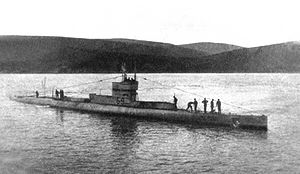HMS G13
 A G-class submarine at Scapa Flow.
| |
| History | |
|---|---|
| Name | G13 |
| Builder | Vickers |
| Laid down | 9 April 1915 |
| Launched | 18 July 1916 |
| Commissioned | 23 September 1916 |
| Fate | Sold, 20 January 1923 to J Smith |
| General characteristics | |
| Class and type | G-class submarine |
| Displacement |
|
| Length | 187 ft 1 in (57.0 m) |
| Beam | 22 ft 8 in (6.9 m) |
| Draught | 13 ft 4 in (4.1 m) |
| Installed power |
|
| Propulsion |
|
| Speed |
|
| Range | 2,400 nmi (4,400 km; 2,800 mi) at 12.5 kn (23.2 km/h; 14.4 mph) surfaced |
| Complement | 30 |
| Armament |
|

HMS G13 was a British G-class submarine built for the Royal Navy during World War I.
Description[edit]
The G-class submarines were designed by the Admiralty in response to a rumour that the Germans were building double-hulled submarines for overseas duties. The submarines had a length of 187 feet 1 inch (57.0 m) overall, a beam of 22 feet 8 inches (6.9 m) and a mean draft of 13 feet 4 inches (4.1 m). They displaced 703 long tons (714 t) on the surface and 837 long tons (850 t) submerged. The G-class submarines had a crew of 30 officers and ratings. They had a partial double hull.[1]
For surface running, the boats were powered by two 800-brake-horsepower (597 kW) Vickers two-stroke diesel engines, each driving one propeller shaft. When submerged each propeller was driven by a 420-horsepower (313 kW) electric motor. They could reach 14.25 knots (26.39 km/h; 16.40 mph) on the surface and 9 knots (17 km/h; 10 mph) underwater. On the surface, the G class had a range of 2,400 nautical miles (4,400 km; 2,800 mi) at 14.25 knots (26.39 km/h; 16.40 mph).[1]
The boats were intended to be armed with one 21-inch (53.3 cm) torpedo tube in the bow and two 18-inch (45 cm) torpedo tubes on the beam. This was revised, however, while they were under construction, the 21-inch tube was moved to the stern and two additional 18-inch tubes were added in the bow. They carried two 21-inch and eight 18-inch torpedoes. The G-class submarines were also armed with a single 3-inch (7.6 cm) deck gun.[1]
War service[edit]
Like the rest of her class, G13's role was to patrol an area of the North Sea in search of German U-boats. On 10 March 1917 G13 torpedoed and sank the German submarine UC-43 off the Shetland Islands, about 9 miles (14 km) NW of Muckle Flugga Lighthouse. Lieutenant Commander George Fagan Bradshaw was awarded the Distinguished Service Order for his command in this action.
G13 survived the war and was sold for scrap in 1923.
Notes[edit]
References[edit]
- Colledge, J. J.; Warlow, Ben (2006) [1969]. Ships of the Royal Navy: The Complete Record of all Fighting Ships of the Royal Navy (Rev. ed.). London: Chatham Publishing. ISBN 978-1-86176-281-8.
- Gardiner, Robert & Gray, Randal, eds. (1985). Conway's All the World's Fighting Ships 1906–1921. Annapolis, Maryland: Naval Institute Press. ISBN 0-85177-245-5.
- McCartney, Innes (2008). British Submarines of World War I. New Vanguard. Vol. 145. Oxford, UK: Osprey. ISBN 978-1-84603-334-6.
